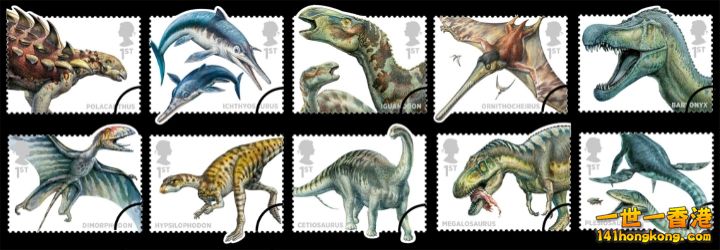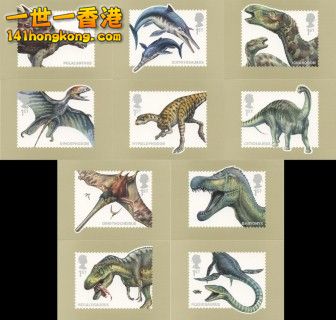|
|
 發表於 2013-11-12 01:47:23
|
顯示全部樓層
發表於 2013-11-12 01:47:23
|
顯示全部樓層
回帖獎勵 +30000 元錢
本帖最後由 edmondcu 於 2013-11-12 02:14 編輯
Country : England
Year : 2013
Take a shufti at these amazing new Dinosaur Stamps – perfect for any Dino Zoo!
The Royal Mail has unleashed 10 beautifully illustrated dinosaur stamps for you to add to your collection. Each stamp features a different dinosaur, all discovered here in the UK. The collection has been brought to life by renowned illustrator John Sibbick in consultation with the expertise of Dr Angela Milner, bringing you anatomically correct dinosaurs in breath-taking detail.


Polacanthus, deriving its name from the Ancient Greek polys-/πολύς- "many" and akantha/ἄκανθα "thorn" or "prickle", is an early armored, spiked, plant-eating ankylosaurian dinosaur from the early Cretaceous period of England.
Ichthyosaurus (derived from Greek ιχθυς/ichthys meaning 'fish' and σαυρος/sauros meaning 'lizard') is a genus of ichthyosaurs from the late Triassic and early Jurassic (Rhaetian - Pliensbachian) of Europe (Belgium, England, Switzerland). It is among the best known ichthyosaur genera, with the Order Ichthyosauria being named after it. Ichthyosaurus was the first complete fossil to be discovered in the early 19th century by Mary Anning in England.
Iguanodon (/ɨˈɡwɑːnədɒn/ i-gwah-nə-don; meaning "iguana-tooth") is a genus of ornithopod dinosaur that existed roughly halfway between the first of the swift bipedal hypsilophodontids of the mid-Jurassic and the duck-billed dinosaurs of the late Cretaceous. While many species have been classified in the genus Iguanodon, dating from the late Jurassic Period to the late Cretaceous Period of Asia, Europe, and North America, research in the first decade of the 21st century suggests that there is only one well-substantiated species: I. bernissartensis, which lived from the late Barremian to the earliest Aptian ages (Early Cretaceous) in Belgium and possibly elsewhere in Europe, between about 126 and 125 million years ago.
Dimorphodon /daɪˈmɔrfədɒn/ was a genus of medium-sized pterosaur from the early Jurassic Period. It was named by paleontologist Richard Owen in 1859. Dimorphodon means "two-form tooth", derived from Greek δι/di meaning 'two', μορφη/morphe meaning 'shape' and οδων/odon meaning 'tooth', referring to the fact that it had two distinct types of teeth in its jaws - which is comparatively rare among reptiles.
Hypsilophodon (/ˌhɪpsɨˈlɒfɵdɒn/; meaning "Hypsilophus-tooth") is an ornithopod dinosaur genus from the Early Cretaceous period of England.
Cetiosaurus (SEET-ee-oh-sawr-us) meaning 'whale lizard', from the Greek keteios/κήτειος meaning 'sea monster' (later, 'whale') and sauros/σαυρος meaning 'lizard', is a herbivorous sauropod dinosaur from the Late Jurassic Period, living about 167 million years ago in what is now Europe.
rnithocheirus (from Greek "ορνις", meaning bird, and "χειρ", meaning hand) is a pterosaur genus known from fragmentary fossil remains uncovered from sediments in the UK.
Baryonyx (/ˌbæriˈɒnɨks/; Greek: βαρύς/barys meaning 'heavy' and ὄνυξ/onyx meaning 'claw' or 'nail') is a genus of carnivorous saurischian dinosaur first discovered in clay pits just south of Dorking, England, and later reported from fossils found in northern Spain and Portugal. It is known to contain only one species, Baryonyx walkeri. Its fossils have been recovered from formations dating from the Hauterivian to early Barremian stages of the early Cretaceous Period, around 130–125 million years ago.
Megalosaurus (meaning "Great Lizard", from Greek μέγας/megas meaning 'big', 'tall' or 'great' and σαυρος/sauros meaning 'lizard') is a genus of large meat-eating theropod dinosaurs of the Middle Jurassic period (Bathonian stage, 166 million years ago) of Southern England.
Plesiosaurus (Greek: πλησιος/plesios, near to + σαυρος/sauros, lizard) was a genus of large marine sauropterygian reptile that lived during the early part of the Jurassic Period, and is known by nearly complete skeletons from the Lias of England. |
|
